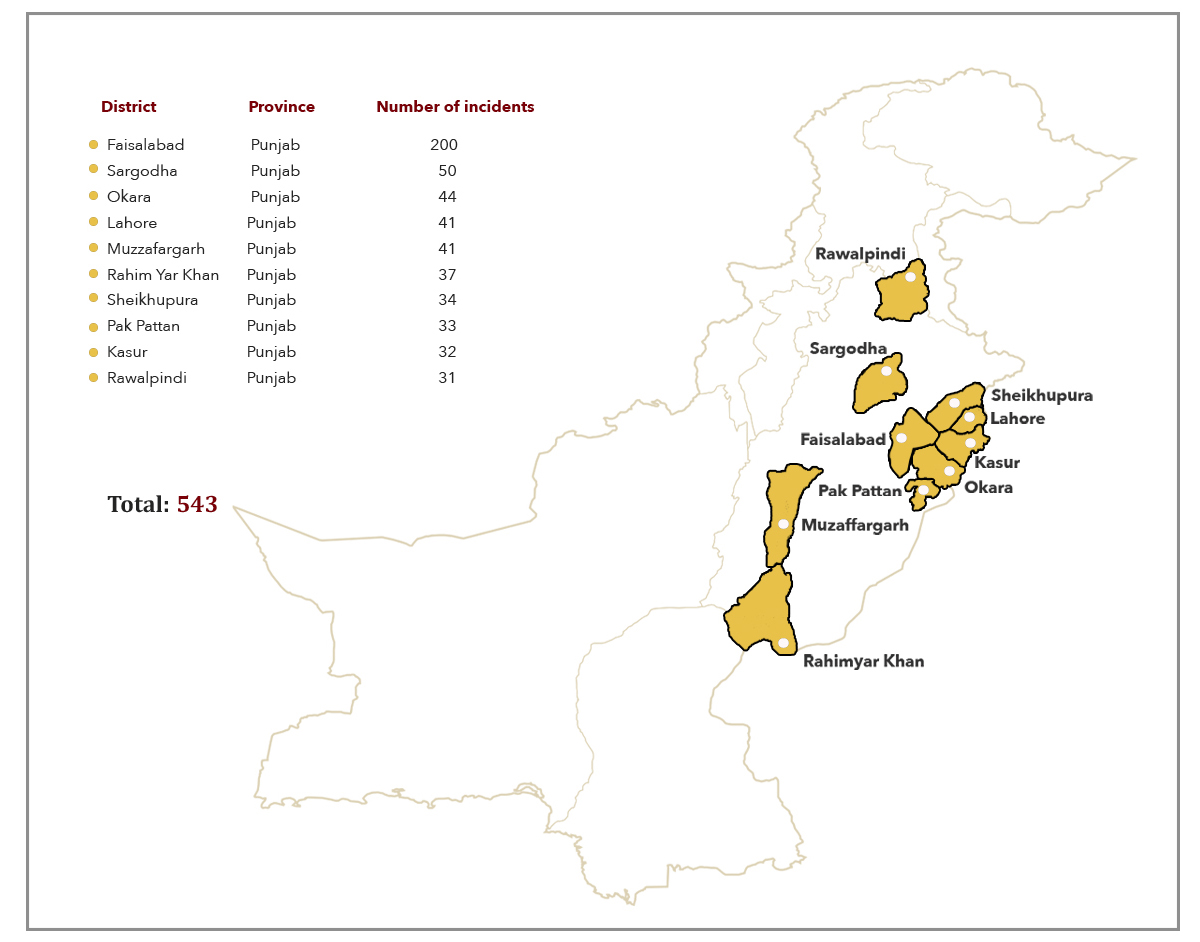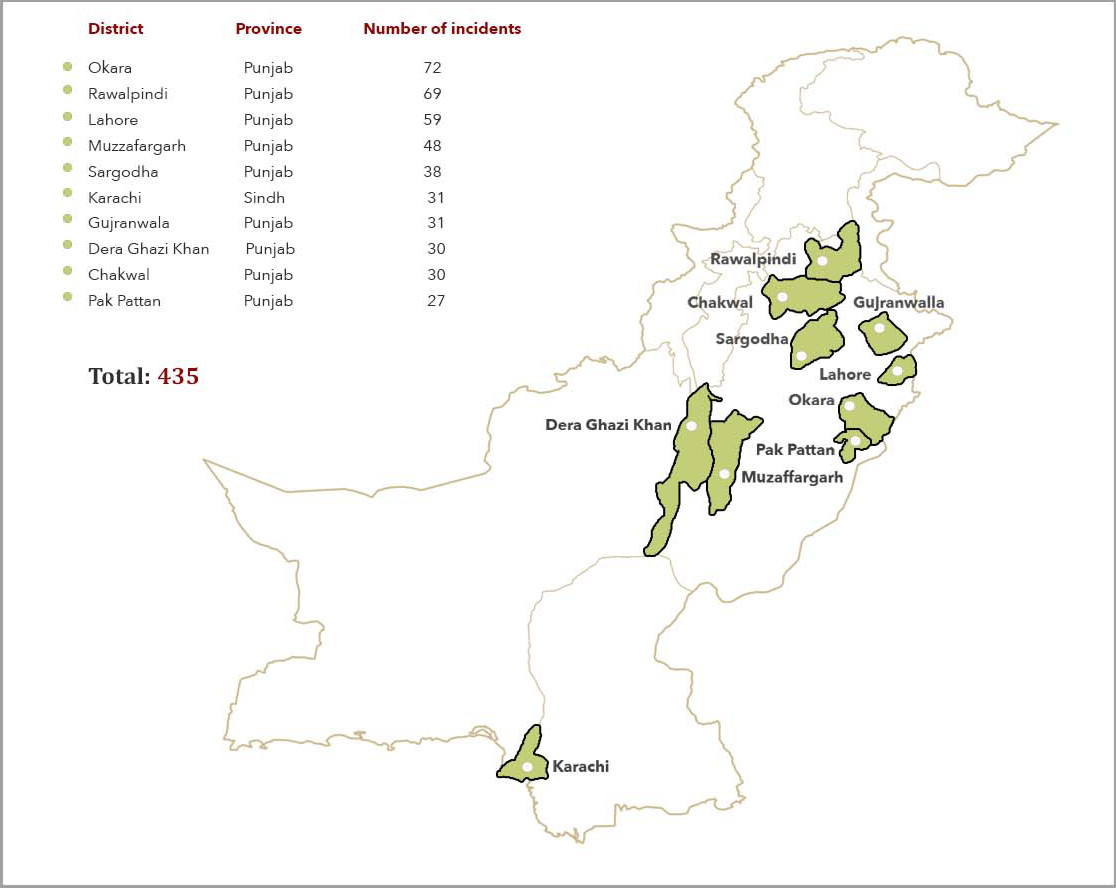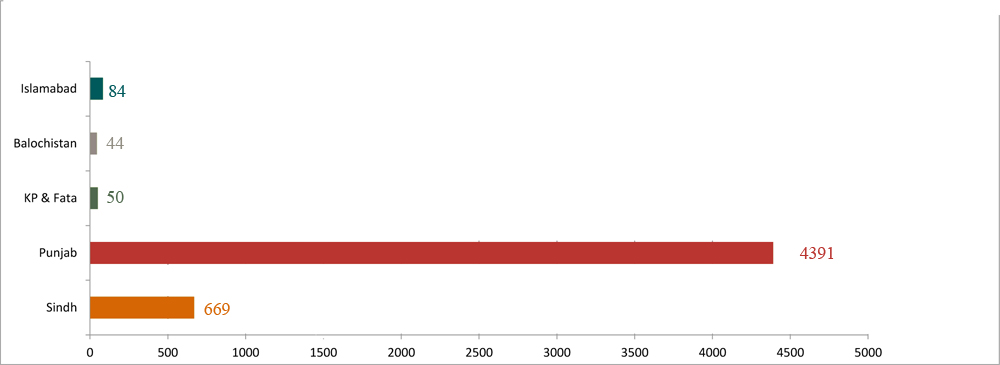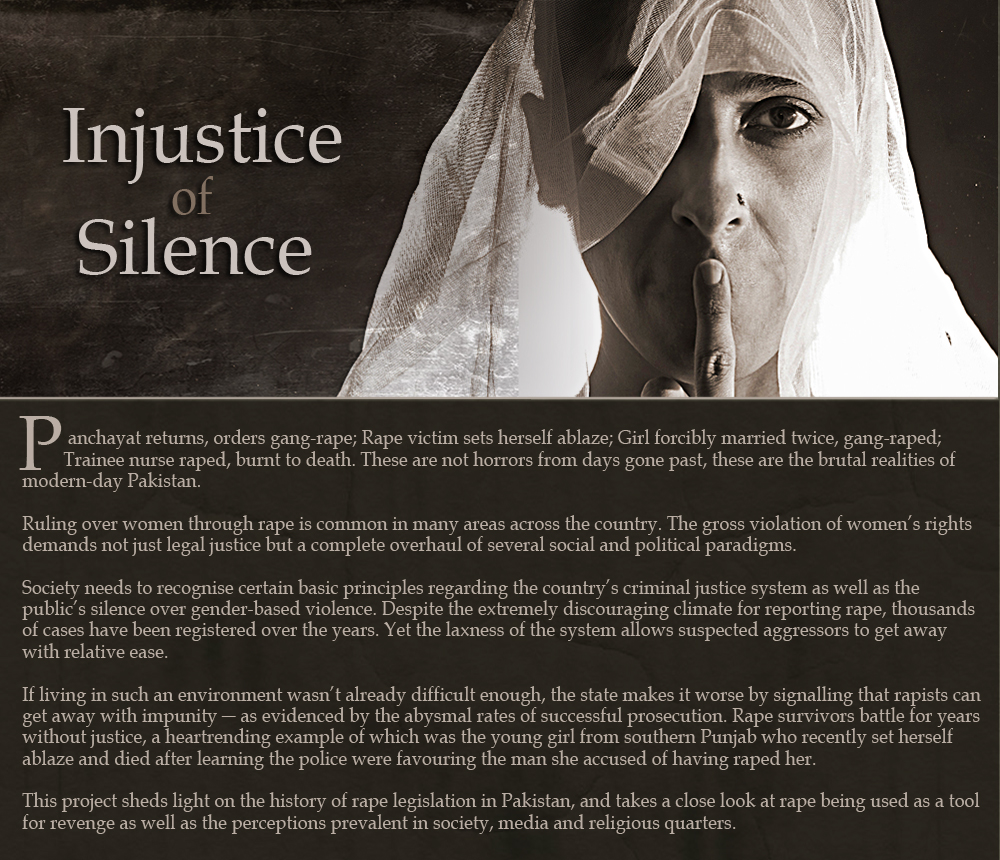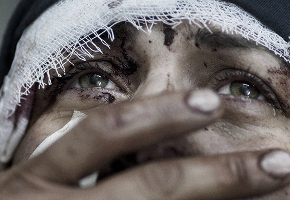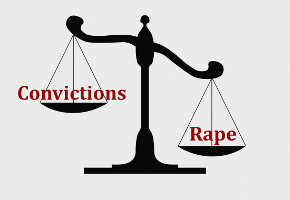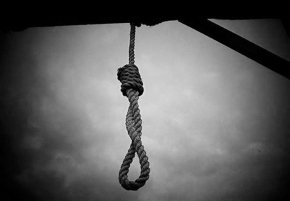This piece was originally published on April 7, 2014.
The Law on Rape in Pakistan: History and Current Scenario
When Pakistan came into being, it adopted laws that existed in the Indian sub-continent as the law of the land. This included the civil and criminal codes in Pakistan. The offence of rape was part of these adopted laws.
The offence drew controversy in 1979 when the military dictator General Ziaul Haq, who decided to
implement an extremely conservative and contentious version of Islamic law in Pakistan, implemented a process from which we are still recovering.
Explore Dawn's special report: Darkness Descends 1977-1988
One of the most catastrophic consequences of this process was the promulgation of the Hudood Ordinances in 1979.
The Hudood Ordinances are a set of five ordinances promulgated that were never debated in parliament.
They are perceived to have been hastily enforced without national debate or evaluation and as a politically expedient measure by the martial law regime to justify its unlawful continuance in power.
One of the casualties of this process of ‘Islamisation’ was the offence of ‘rape’ — which originally came
under the Pakistan Penal Code.
It was subsequently removed and thereafter placed in the Zina Ordinance 1979 — one of the five Hudood Ordinances.
The Hudood Ordinances, particularly the Zina Ordinances, were severely criticised as being incredibly
discriminatory and oppressive especially towards women and other marginalised sections of society.
Women and human rights organisations as well as leading jurists, members of intelligentsia, journalists and academicians, have opposed these laws as being unjust and against the true spirit of Islam.
Even on an official level, (Commission for the Inquiry of Women, 1997 and the Special Committee of the National Commission on the Status of Women) set up to review the situation of women, recommended their repeal unanimously, or with a very significant majority.
Despite this strong opposition these laws were considered ‘un-touchable’ for 27 years due to their ‘Islamic’ nature.
The ordinances manifested in numerous forms of discrimination against women and minorities due to their provisions as well as the manner and method for which they were used.
For example:
- Testimony of women and minorities excluded as a whole.
- Rape and adultery were equated: With rape being considered a ‘form of adultery’
- Law of evidence made discriminatory: The law required four adult Muslim men to witness the entire act of ‘adultery’ vis a vis rape – thereby leading to the lack of prosecution and impunity given to rapists.
- Previous legal protection to children removed equating puberty with adulthood – removing the age old accepted legal norm that children have an immaturity of the mind to fully comprehend the acts they commit and are thereby granted leniency.
- Pregnancy can be used as proof against women: Cases of rape were converted into cases of adultery in case a woman could not prove the rape. Her pregnancy and her reporting of rape were taken as her admission of fornication.
- Distinction between ‘attempt’ to rape and ‘preparation’ to rape with the latter carrying a lighter penalty.
- Discriminatory definition of adult: A female is considered an adult at 16 or puberty – puberty being interpreted as physical maturity (i.e. age of menstruation, which can happen as early as 9 or 10 years) as opposed to mental maturity, and thereby entitled to adult punishment. Ironically, while a girl child cannot be a valid witness for awarding a Hadd punishment she is considered an adult for the imposition of one.
- A permanent state of harassment for women: the law as used to harass, exploit and control women
throughout its existence. Women were imprisoned under the charge of Hadd and remained imprisoned for years. Investigation shows that women in jail on charges of Zina had been put there by their fathers, brothers and husbands.
Supporters of the law claimed that the intention behind the ordinance was to protect women from heinous crimes such as rape, but the practical application does the opposite.
In reality, it was used to torment women who marry of their choice, wives wishing to get a divorce, divorced women wishing to re-marry or who try to get custody of the children etc — it is a power tool compromising women’s fundamental rights.
The Zina Ordinance was finally amended by the Protection of Women (Criminal Law) Amendment Act:
This law made a number of instrumental and practical changes to directly challenge the injustices that had become part of the system when dealing with such cases:
- Hadd and Tazir offences/punishments are separated.
- Rape (Zina bil jabr) separated from fornication/adultery (Zina) and inserted in the Pakistan Penal. Code (PPC).
- Fornication introduced in the PPC as Tazir offence.
- Procedure for complaint of Zina and Qazf changed with applications being made directly to the sessions court as opposed to an FIR to the police.
- Overriding nature of Zina and Qazf Ordinances done away with.
- The offence of rape is now in the Pakistan Penal Code 1860.
Rape and punishment of rape fall under Sections 375 and 376 respectively of the Pakistan Penal Code.
This means that the evidentiary criteria and requirement of proof needed will be the same as any other crime, thereby allowing admission of evidence such as circumstantial evidence, forensic evidence (such as DNA) and placing high value on the testimonies of the victims etc.
The punishment for rape is death or imprisonment not less than 10 years or more than 25 years and a fine.
For gang-rape, each of persons shall be punished with death or imprisonment for life.
Section 375 defines rape as:
Rape:
A man is said to commit rape who has sexual intercourse with a woman under circumstances falling
under any of the five following descriptions,
(i) against her will.
(ii) without her consent
(iii) with her consent, when the consent has been obtained by putting her in fear of death or of
hurt,
(iv) with her consent, when the man knows that he is not married to her and that the consent is given because she believes that the man is another person to whom she is or believes herself to
be married; or
(v) With or without her consent when she is under sixteen years of age.
Explanation: Penetration is sufficient to constitute the sexual intercourse necessary to the offence of
rape.
This definition of rape makes clear certain aspects of the commission of this crime:
The women/girl must give clear, unencumbered and actual consent to sexual intercourse. Without this consent, it is rape. A girl below the age of 16 cannot consent to sexual intercourse.
This is an extremely important point to note which requires further explanation. The law on rape previous to this section in the Zina Ordinance 1979 defined rape (Zina bil jabr) as:
“A person is said to commit Zina bil jabr if he or she has sexual intercourse with a woman or man as the case may be, to whom he or she is not validly married….”
The words “to whom he or she is not validly married” have been removed in Section 375 of the Pakistan
Penal Code 1860.
There is an accepted understanding of the law that if words have been specifically removed from legislation, it is meant to have a specific effect.
Therefore the removal of the requirement of marriage as a defence to forced intercourse means that the relationship between man and a woman is immaterial if sexual intercourse is forced or committed against the consent of a woman – whether she is or is not his wife.
Should we then conclude that regardless of the marital status, sexual intercourse with a girl under the age of 16 is rape?
While it is evident that there is a wide law on rape, which covers important issues of child and marital rape, the issue arises as to the low rate of prosecution.
This unfortunately links up with the earlier discussion relating to the social content of Pakistan.
The implementation of the law and the prosecution of rape cases are conducted within this social context.
Resultantly, police officers, lawyers and even the judges have time and time again been seen to misapply this law.
Investigations are not conducted properly or thoroughly; forensic evidence is not collected correctly or
mishandled; incorrect FIRs are registered which do not effectively capture the whole offence or do not
report all aspects of the case (whether the police does this through negligence, lack of knowledge or maliciously is subjective).
Further, predominant male lawyers and prosecutors and judges are sympathetic towards the perpetrators and strive for the decision to be in their favour.
Alongside this, in many circumstances, a protective approach was adopted resulting in misapplication of the law i.e. to ‘protect’ the ‘vulnerable’ women through not giving them the status of raped women (by declaring child marriages valid); not registering cases and arranging compromises due to the issues with the legal system and the added trauma that women often go through due to the court case; or pushing for the woman not to ‘shame’ herself and admit in public that she is tainted and thereafter ‘ruining’ her life’.
This attitude is wrong because it further violates the legal rights of the woman and allows impunity to perpetrators.
Whatever the circumstances are, malicious or protective, cases of reported rape and prosecution of rapists are far and few.
Despite the handful of positive cases and case law, the majority of situations result in impunity for the perpetrators.
Recent positive judgements of the Supreme Court of Pakistan in the case of Salman Akram Raja and Tahira Abdullah vs. Government of Punjab 2013 [Link to copy of the judgement] must be implemented across the nation.
This includes police stations receiving rape complaints should involve reputable civil society organisations for the purpose of legal aid and counselling; administration of DNA tests and preservation of DNA evidence should be made mandatory in rape cases; a victim’s statement should be recorded under section 164, Code of Criminal Procedure, 1898, preferably by a female Magistrate; trials for rape should be conducted on camera and after regular court hours; during a rape trial, screens or other arrangements should be made so that the victims and vulnerable witnesses do not have to face the accused persons; and evidence of rape victims should be recorded, in appropriate cases, through video conferencing so that the victims, particularly juvenile victims, do not need to be present in court.
It is extremely important to re-examine the entire scheme, processes and procedures in relation to the
investigation and implementation of cases of rape in Pakistan.
The role of the police must be re-examined and better training and sensitisation must be ensured.
It is also important to keep regular monitoring and checks on judgements to eliminate anti-women societal bias.
These steps must be taken to ensure the impunity given to perpetrators of rape must end and victims be given the justice they deserve.
The author is a high court Advocate.
Rape laws: colonial influences, consent and inclusion
By Soonha Abro
Few people in Pakistan, or perhaps even in the subcontinent, are aware that our rape laws were inherited from the British colonisers.
The Indian Penal Code (IPC) was approved in 1860, and came into effect in 1862. Incidents like the 1857 Mutiny/War of Independence both interrupted and influenced its drafting process. Then in 1872, the British government introduced the Indian Law of Evidence. Pakistan inherited both of these after partition.
Nineteenth century British society had strict standards about every aspect of social life, particularly on the interactions between men and women. Simultaneously, the colonial era was at its peak. These conservative sexual mores were then transmitted to Britain’s colonies as the colonial masters attempted to ‘civilise’ the indigenous populations. Particularly in India, these mores were ingrained so deeply into the native consciousness that these mores eventually became a permanent characteristic of the local culture.
The IPC was based on these conservative standards. Furthermore, it was a legal method for controlling most of India, and an integral part of the civilising campaign launched by the British to further their colonial ambitions in India.
Being gender-specific, the laws presume that the victim is always a woman and the perpetrator a man – which makes them problematic.
Despite the laws being geared towards women, human rights and feminist activists widely criticised them for their limited in scope and inability to cater to the needs of women.
The laws neglect two extremely important issues: first consent, and second, the difference between consensual and non-consensual sex between adults of any sexual orientation and varying gender identities.
In India, rape is addressed in the Sections 375 and 376 of the IPC. Several other sections address various forms of sexual harassment. Other criminal statutes are the Code of Criminal Procedure 1973 and the Indian Evidence Act 1872. A number of amendments were introduced in these laws through the Criminal Law (Amendment) Act 2012 and 2013.
Rape cases in Pakistan were initially prosecuted under the civil criminal code until 1979, when General Ziaul Haq introduced the Hudood Ordinance. Paragraph VII of this ordinance (Zina) replaced Sections 375 and 376 (on rape) in the Pakistan Penal Code (PPC).
The Qanoon-i-Shahadat (Law of Evidence) was introduced in 1984 and repealed the Law of Evidence of 1872. These laws were said to have been derived from Islam and the Shariah.
Under the Zina laws, adultery was punishable by stoning, and testimonies of four adult male Muslim witnesses were required as evidence. In the case of rape, the burden of proof lay with a woman who was required to produce the requisite number of witnesses to testify to her rape.
Her inability to provide witnesses, in many instances, resulted in her inadvertent admission of adultery and she would be charged accordingly. This especially held true if an unmarried rape survivor was impregnated as a result of the rape.
In 2006, rape prosecution was returned to the legal jurisdiction of the civil criminal code.
There, however, remain numerous loopholes in our legal system make it easy to exploit these laws.
Moreover, rape is largely understood to be the carnal knowledge of a woman without her consent. The scope of this definition is disturbingly narrow and limited making it is easier for the society to neglect an incident of rape that does not adhere to its specific definition.
Incidents in which a man is sexually assaulted by a woman, or by another man, or a woman or man is gang raped by a group of individuals of either sex do not adhere to the above definition. For this reason, existing definitions of rape need to be broadened and made gender-neutral.
As our social, legal, and political institutions are already loath to providing the female sexual assault victims with the necessary legal, medical and psychological help, it is no surprise that they refuse similar assistance to men and genderqueer victims of sexual assault.
The term genderqueer covers all gender identities that are not specifically man or woman.
Genderqueer individuals typically identify as one or more of the following:
1. Both man and woman
2. Neither man nor woman
3. Moving between genders, or a variable gender identity
4. Third-gendered, or other-gendered, including all those people who do not describe their gender in a specific category
5. Having an overlap or a blur between gender identity, and sexual and romantic orientation.
Following the Delhi rape case of December 2012, the Verma Committee was established and tasked with recommending amendments to the existing laws on rape and other sexual offences so that the perpetrators were prosecuted promptly and duly punished. The committee submitted its recommendations on January 23, 2013.
The committee presented its most important recommendation: a broader definition of rape, which was more gender-neutral, and included all possible methods of penetration.
But when the Criminal Law (Amendment) Act was passed in March 2013, the definition of rape remained as limited in the context that the laws were still based on the assumption that a woman is always the victim and the man the perpetrator in cases of rape, sexual assault, and harassment.
These amendments did not even consider the possibility of sexual assault cases against people with varied gender and sexual identities. Hence, the amended laws resulted in a setback to the inclusion of genderqueer victims of sexual offences into the mainstream, and the introduction of gender-neutral rape laws.
Several experts have, over the years, argued in favour of reforming our rape laws, and rightly so. Why keep a law that is full of holes, and cannot function properly? Why keep a law that blames the victims, instead of punishing the perpetrators? As gender identities and the politics of sexual violence continue to evolve, the need to reform the rape laws is becoming increasingly crucial.
Rape can never be equal to “adultery by force”
By Tahira Abdullah — Islamabad-based researcher, development worker, peace activist & human rights defender.
Rape can never be equal to “adultery by force”. No debate, no discussion. This issue is so palpable that
it does not require further explanation. But that is not the case is the Land of the Pure, where nothing is simply assumed.
Rape has been a murky life-and-death issue for Pakistani women since 1979, and anyone who thought the issue was resolved by the enactment of the Women’s Protection Act (WPA/2006) needs to think again.
The mullah brigade subsequently challenged the WPA’s “Islamic” credentials in the Zia-constituted
Federal Shariat Court, the unconstitutional status which is a bone of contention between constitutionalists, women, non-Muslim Pakistanis and human rights defenders on the one hand, and the right-wing Islamist orthodoxy, including some judges/lawyers, religio-political parties, and the mullah brigade on the other.
But, to discuss the issue from the beginning we need to take a closer at the Zia-imposed Islamisation of legal proceedings.
The ruthless, hypocritical “Islamist”, General Ziaul Haq, during his brutal martial law regime (1977-88),
undertook a series of “Islamisation” measures, in a futile bid to perpetuate his unconstitutional rule and to try to gain international “legitimacy” via the Saudi-Pak orthodoxy.
One of these steps was his promulgation of, inter alia, the Hudood Ordinances (1979), the most
calculatedly vile of which was the Zina Ordinance.
Much has been written about the injustice and discrimination against women in the Zina Ordinance
by women’s rights activists, constitutional experts as well as the legal fraternity. To put it simply it
equates adultery with rape, albeit “adultery by force” (sic) – ignoring the irrefutable fact that adultery is
extra-marital consensual relations. On the other hand rape is, by definition in other parts of the world,
unquestionably a violent crime carried out forcibly and without the consent of one party.
The Zina Ordinance excluded the testimony of Muslim women and non-Muslim Pakistanis (unless the
accused was non-Muslim) in adultery and rape cases. It prescribed death by stoning for both adultery
and rape. Additionally, it changed the age of majority from 16 (girls) and 18 (boys) to the age of attaining puberty, in effect rendering little girls aged 9, 10 or 11 liable to be sentenced to death by stoning for adultery/fornication if they were raped. If a girl/woman became pregnant as a result of rape, she could not opt for an abortion, as that would be illegal, but her pregnancy was per se considered a self-evident confession of guilt to the charge of adultery.
The WPA (2006), inter alia, simply removed rape from the Zina Ordinance, putting it back in the Pakistan Penal Code (PPC), with a few changes. It retained the other provisions cited above, including stoning to death for Zina (but not rape). The fact is that while the Quran deals with adultery/fornication, rape is not mentioned at all.
Dictator Zia sought to indemnify and perpetuate his illegal deeds, by enacting the Eighth Constitutional Amendment (CA, 1985), which incorporated all his legislative promulgations, including the Zina
Ordinance.
Women’s rights defenders strenuously sought to get the amendment repealed by the Constitutional
Reforms Committee for the Eighteenth CA (2010). However, there was no appetite for this, even in the
“progressive” PPP government-led committee, comprising all the political parties in parliament. Again,
the issue of rape and Zina refuses to go away.
In addition to being a legal and religious issue, rape is also – importantly – a semantic issue in Pakistan.
“Zina” literally means “adultery” in Arabic, Persian and Urdu. Rape is erroneously translated into Urdu
(but not in Arabic) as “zina bil-jabr” (literally: “adultery by force”), or euphemistically termed “ziyadati”
(“going too far”), “izzat lootna” or “ismat-darri” (“dishonouring [a woman]”).
In English, the Pakistani police, judiciary and the media mostly tend to use euphemisms such as
“molestation”, “assault”, or “dishonour” instead of “rape”. All these terms, both in Urdu and English,
send out the wrong messages — either that the “sin/crime of illicit sexual intercourse was committed”,
even if it was rape, forcibly carried out by the man without consent from the woman; or that “rape equals dishonouring a woman”; or that “it was the trifling crime of molestation – no big deal at all” (sic).
So what is to be done? A number of steps need to be taken:
Semantics: We must insist that rape is termed rape, not assault, molestation, dishonouring, or any other euphemism that diminishes the crime.
Criminalisation: Rape/gangrape is usually a crime of Violence against Women and Girls (VAWG).
Religion must not be permitted to muddy the legal waters.
Myth: Women never “ask” to be raped, or “provoke it”, or “enjoy it”, no matter what they wear or do.
Police, lawyers and judges must understand this. Privacy: The identity and personal details of rape survivors and their families must not be revealed, in order to protect them and to retain their privacy, dignity and respect. Conversely, the names and photographs of the rapists should be revealed.
Services: Rape survivors need urgent assistance by the police; medico-legal examination; legal aid (free if required); FIR registration, investigation, prosecution and support through a fast-tracked and simplified judicial process; psycho-social trauma counselling and rehabilitation; and, not least, health services (including legal abortion services if the rape results in pregnancy).
Support: Emotional support from the survivor’s family and larger circle is critical in the psychological
rehabilitation process.
Laws: Progressive legislative reform is required to be carried out in both the national and provincial
legislatures, to rectify the blatant injustice and discrimination against women and non-Muslim Pakistani citizens.
Education: Reforms are required in the school education curricula, textbooks and teachers’ training
curriculum, to inculcate concepts of human rights and respect for women/girls, as well as gender justice and equality.
Media: The public/private print and electronic media need to strictly adhere to the Uks Code of Ethics,
which they have voluntarily accepted.
Our message to all past, present [and future] rapists is: “Our honour is not in your hands, your body or
your mind. It is also not in our bodies which you seek to control by brute force. Our honour is inherent
and intrinsic; it resides in our minds, hearts and souls, where you can never reach; and which you will
never control”.
